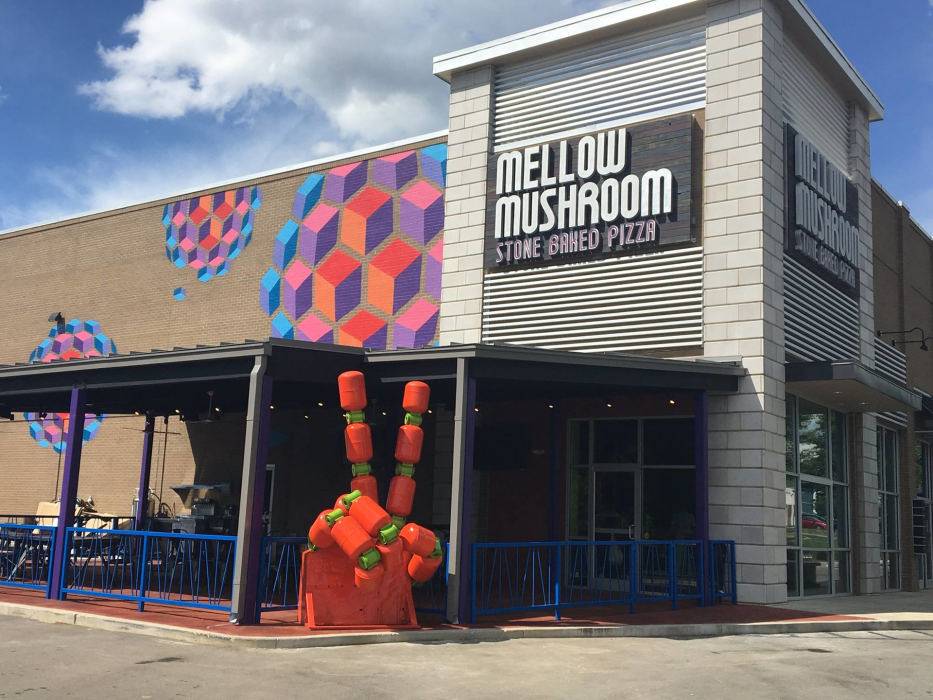Photo Source: Mellow Mushroom
Like a single slice of pizza, a franchise unit can have its own unique flavor. But if a brand wants to create a consistent customer experience, then it needs to create a franchise strategy that’s more like a pizza pie — cohesive and unified.
Psychedelic pizza chain Mellow Mushroom baked up a consistent customer experience strategy for all of its restaurants by using technology to collect customer feedback from disparate data sources.
Pinpointing a problem
With nearly 200 locations nationwide, Mellow Mushroom receives a lot of customer feedback across various channels, including email, national and local social channels, and review sites like Yelp. In the past, franchise managers were tasked with visiting all of these channels and responding to customers’ positive and negative comments. Annica Kreider, VP of brand development for Mellow Mushroom, says each restaurant even receives a quarterly score based how they respond.
Kreider wanted to find an easier way to bring these different data sources together and enable managers to respond to comments more quickly.
“When our operators are more efficient,” she says, “they can deliver a better customer experience.”
So in 2015, Mellow Mushroom implemented customer feedback solution InMoment.
Serving up a solution
According to Andrew Park, senior director of customer experience strategy for InMoment, InMoment is a cloud-based solution that both collects customer feedback and ingests data from other channels into a single place. There are a number of ways Mellow Mushroom uses this solution, too.
One way is through its customer feedback portal Tell Mellow. After visiting a Mellow Mushroom restaurant, customers receive a receipt inviting them to fill out an online survey in exchange for $5 off their next visit. Kreider says Mellow Mushroom can ask customers questions about a range of topics, like new menu items or limited-time offers. This information is then entered into InMoment’s system.
Another way Mellow Mushroom uses InMoment is by having the technology scour social channels and review sites for Mellow Mushroom mentions. Once these mentions are identified, InMoment will send a local manager an email notifying him or her that there’s a comment that needs a response.
In addition, Mellow Mushroom gathers customer feedback through direct inquiries. If a customer sends Mellow Mushroom an online catering request, for instance, InMoment will ingest the data associated with that inquiry (e.g. the inquirer’s name, email, phone number, and party size) and send the local manager an alert notifying him or her of the request. Similarly, if a customer clicks the “contact” button on Mellow Mushroom’s website, he or she can send the brand an email about a particular restaurant location and topic (e.g. employment, feedback, nutritional information). Again, this data is consumed by InMoment and the appropriate manager receives a notification.
“It’s really allowed us to up our game,” Kreider says.
Digesting the data
Mellow Mushroom uses customer feedback in a number of ways, including research and development purposes. It’s also helped the brand make small, actionable changes. After surveying customers about a new menu, for instance, Kreider says Mellow Mushroom learned that many customers thought the menu font was too small. So, the brand asked its agency to redesign it.
These feedback solutions have also helped Mellow Mushroom collect even more data about its customers. Customers are invited to opt in to Mellow Mushroom’s email program EClub, which has 600,000 members per Kreider’s count, via a number of feedback touchpoints. In fact, she says that Tell Mellow is the brand’s highest list-building source for the brand’s email program.
“It definitely helps us to build on our CRM,” she says.
Once customers have been a member of the email program for 90 days, Kreider says, they receive a survey inviting them to tell Mellow Mushroom more about themselves, such as their interests and nutritional preferences. This data allows Mellow Mushroom to send more targeted messages. So if a customer indicates that he’s gluten free, Kreider explains, Mellow Mushroom might send him a message about its gluten-free crust.
“Our open rates are 20% higher than what you might see in casual dining as a whole,” she notes.
In addition, the data allows executives at Mellow Mushroom headquarters to see how the brand is performing at both a franchise and company-wide level, Kreider says. This helps the brand identify where some restaurants might be lacking.
Watching the results rise
Since leveraging the platform, Mellow Mushroom has seen a 17% increase in customers’ likelihood to recommend the brand as a restaurant worth trying.
“For us, word-of-mouth advertising is so critical to what we do,” Kreider says.
In terms of areas of improvement, she says that she hopes to enhance the brand’s suggested selling methods. Not only does recommending menu items increase the order value, she says, but it also seems to provide a better customer experience.
“If a guest had an item suggested to them, their satisfaction level is higher,” she says.
As for the biggest challenge throughout this whole experience, Kreider says it can be difficult for franchisees to accept that their customer satisfaction levels might not be “up to par.” But if there’s one thing she’s learned from this process it’s this: “The data doesn’t lie.”
“I’m a firm believer in [the notion] that the numbers tell a story,” Kreider says, “and it’s the truth.”







